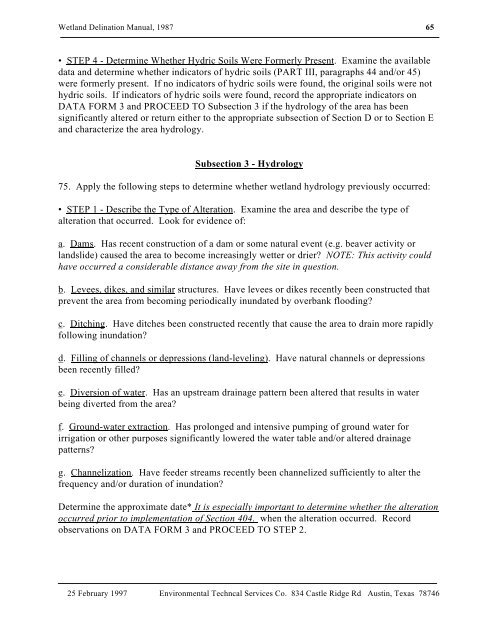1987 Wetland Delineation Manual - The Wetlands Regulation Center
1987 Wetland Delineation Manual - The Wetlands Regulation Center
1987 Wetland Delineation Manual - The Wetlands Regulation Center
You also want an ePaper? Increase the reach of your titles
YUMPU automatically turns print PDFs into web optimized ePapers that Google loves.
<strong>Wetland</strong> Delination <strong>Manual</strong>, <strong>1987</strong> 65<br />
• STEP 4 - Determine Whether Hydric Soils Were Formerly Present. Examine the available<br />
data and determine whether indicators of hydric soils (PART III, paragraphs 44 and/or 45)<br />
were formerly present. If no indicators of hydric soils were found, the original soils were not<br />
hydric soils. If indicators of hydric soils were found, record the appropriate indicators on<br />
DATA FORM 3 and PROCEED TO Subsection 3 if the hydrology of the area has been<br />
significantly altered or return either to the appropriate subsection of Section D or to Section E<br />
and characterize the area hydrology.<br />
Subsection 3 - Hydrology<br />
75. Apply the following steps to determine whether wetland hydrology previously occurred:<br />
• STEP 1 - Describe the Type of Alteration. Examine the area and describe the type of<br />
alteration that occurred. Look for evidence of:<br />
a. Dams. Has recent construction of a dam or some natural event (e.g. beaver activity or<br />
landslide) caused the area to become increasingly wetter or drier? NOTE: This activity could<br />
have occurred a considerable distance away from the site in question.<br />
b. Levees, dikes, and similar structures. Have levees or dikes recently been constructed that<br />
prevent the area from becoming periodically inundated by overbank flooding?<br />
c. Ditching. Have ditches been constructed recently that cause the area to drain more rapidly<br />
following inundation?<br />
d. Filling of channels or depressions (land-leveling). Have natural channels or depressions<br />
been recently filled?<br />
e. Diversion of water. Has an upstream drainage pattern been altered that results in water<br />
being diverted from the area?<br />
f. Ground-water extraction. Has prolonged and intensive pumping of ground water for<br />
irrigation or other purposes significantly lowered the water table and/or altered drainage<br />
patterns?<br />
g. Channelization. Have feeder streams recently been channelized sufficiently to alter the<br />
frequency and/or duration of inundation?<br />
Determine the approximate date* It is especially important to determine whether the alteration<br />
occurred prior to implementation of Section 404. when the alteration occurred. Record<br />
observations on DATA FORM 3 and PROCEED TO STEP 2.<br />
25 February 1997 Environmental Techncal Services Co. 834 Castle Ridge Rd Austin, Texas 78746


